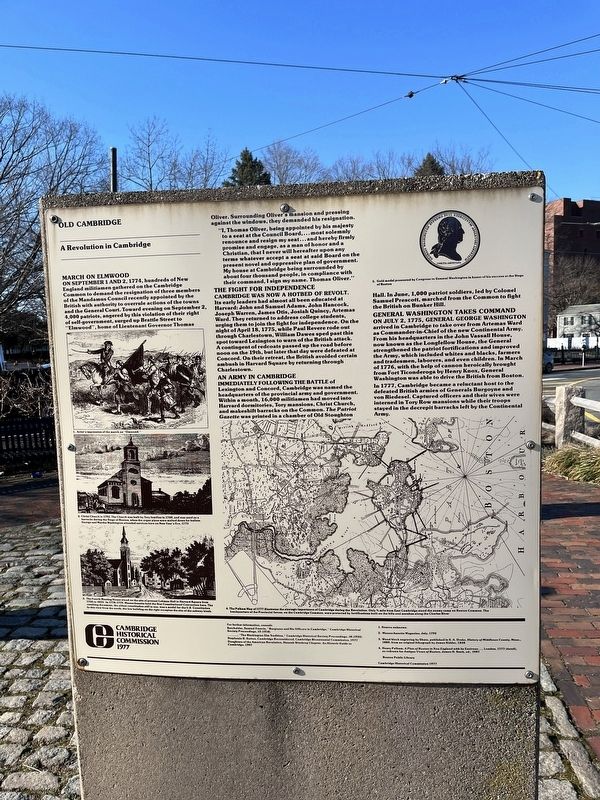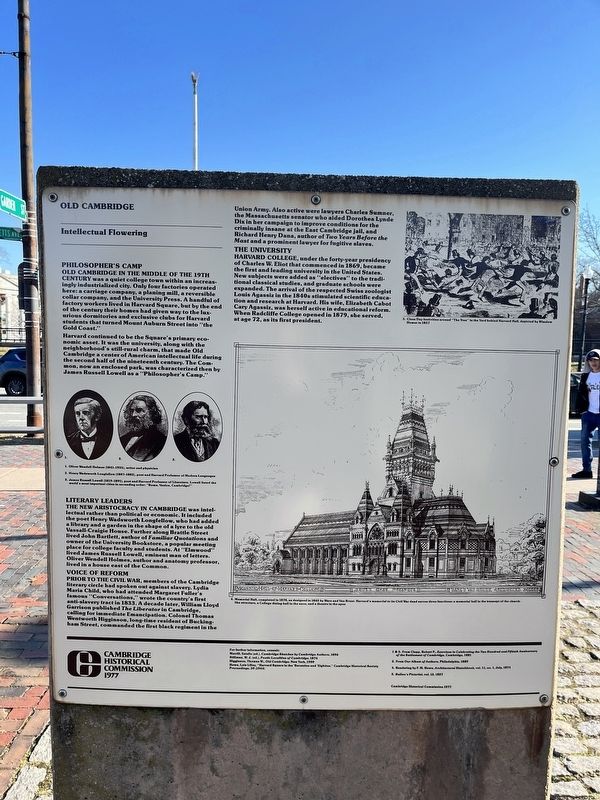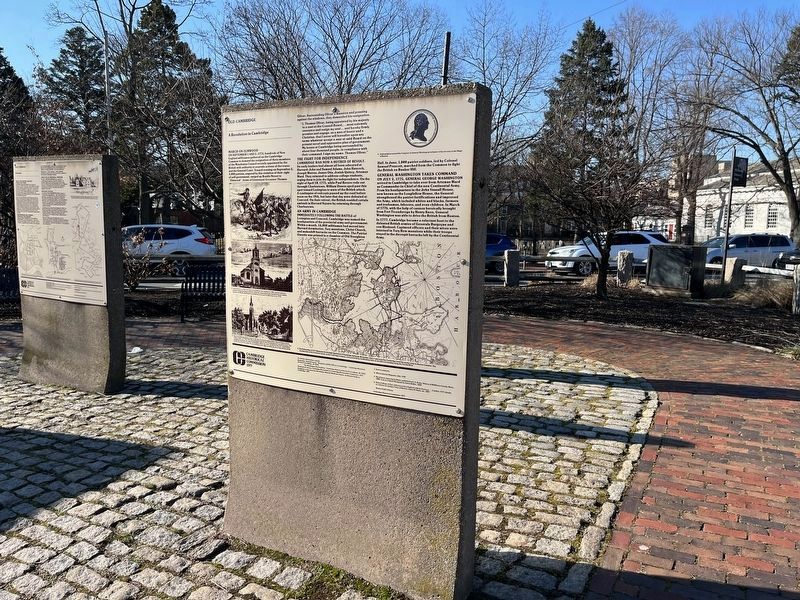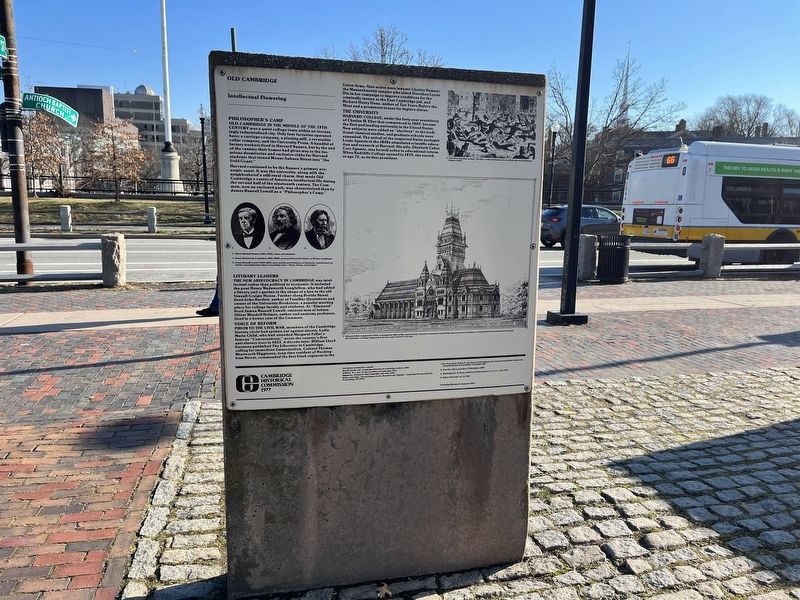Neighborhood Nine in Cambridge in Middlesex County, Massachusetts — The American Northeast (New England)
Old Cambridge
A Revolution in Cambridge / Intellectual Flowering
A Revolution in Cambridge
March on Elmwood
On September 1 and 2, 1774, hundreds of New England militiamen gathered on the Cambridge Common to demand the resignation of three members of the Mandamus Council recently appointed by the British with authority to overrule action of the town and the General Court. Toward evening on September 2, 4,000 patriots, angered by this violation of their right of self-government, surged up Brattle Street to "Elmwood", home of Lieutenant Governor Thomas Oliver. Surrounding Oliver's mansion and pressing against the windows, they demanded his resignation.
"I, Thomas Oliver, being appointed by his majesty to a seat at the Council Board,…most solemnly renounce and resign my seat…and hereby firmly promise and engage, as a man of honor and a Christian, that I never will hereafter upon any terms whatever accept a seat at said Board on the present novel and oppressive plan of government. My house at Cambridge being surrounded by about four thousand people, in compliance with about four thousand people, in compliance with their command, I sign my name. Thomas Oliver"
The Fight for Independence
Cambridge was now a hotbed of revolt. Its early leaders had almost all been educated at Harvard: John and Samuel Adams, John Hancock, Joseph Warren, James Otis, Josiah Quincy, Artemas Ward. They returned to address college students, urging them to join the fight for independence. On the night of April 18, 1775, while Paul Revere rode out through Charlestown, William Dawes sped past this spot toward Lexington to warn of the British attack. A contingent of redcoats passed up the road before noon on the 19th, but later that day were defeated at Concord. On their retreat, the British avoided certain ambush in Harvard Square by returning through Charlestown.
An Army in Cambridge
Immediately following the battle of Lexington and Concord, Cambridge was named the headquarters of the provincial army and government. Within a month, 16,000 militiamen had moved into Harvard dormitories, Tory mansions, Christ Church, and makeshift barracks on the common. The Patriot Gazette was printed in a chamber of Old Stoughton Hall. In June, 1000 patriot soldiers, led by Colonel Samuel Prescott, marched from the Common to fight the British on Bunker Hill.
General Washington Takes Command
On July 2, 1775, General George Washington arrived in Cambridge to take over from Artemas Ward as Commander-in-Chief of the new Continental Army. From his headquarters in the John Vassall House, now known as the Longfellow House, the General strengthened the patriot fortifications
In 1777, Cambridge became a reluctant host to the defeated British armies of Generals Burgoyne and von Riesdesel. Captured officers and their wives were interned in Tory Row mansions while their troops stayed in the decrepit barracks left by the Continental Army.
Intellectual Flowering
Philosopher's Camp
Old Cambridge in the middle of the 19th century was a quiet college town within an increasingly industrialized city. Only four factories operated here: a carriage company, a planing mill, a reversible collar company, and the University Press. A handful of factory workers lived in Harvard Square, but by the end of the century their homes had given way to the luxurious dormitories and exclusive clubs for Harvard students that turned Mount Auburn Street into "the Gold Coast."
Harvard continued to be the Square's primary economic asset. IT was the university, along with the neighborhood's still-rural charm, that made Old Cambridge a center of American intellectual life during the second half of the nineteenth century. The Common, now an enclosed park,
Literary Leaders
The new aristocracy in Cambridge was intellectual rather than political or economic. It included the poet Henry Wadsworth Longfellow, who had added a library and a garden in the shape of a lyre to the old Vassal-Craigie House. Further along Brattle Street lived John Bartlett, author of Familiar Quotations and owner of the University Bookstore, a popular meeting place for college faculty and students. At "Elmwood" lived James Russell Lowell, eminent man of letters. Oliver Wendell Holmes, author and anatomy professor, lived in a house east of the Common.
Voice of Reform
Prior to the Civil War, members of the Cambridge literary circle had spoken out against slavery. Lydia Maria Child, who had attended Margaret Fuller's famous "Conversations," wrote the country's first anti-slavery tract in 1833. A decade later, William Lloyd Garrison published The Liberator in Cambridge, calling for immediate Emancipation. Colonel Thomas Wentworth Higginson, long-time resident of Buckingham Street, commanded the first black regiment in the Union Army. Also active were lawyers Charles Sumner, the Massachusetts senator who aided Dorothea Lynde Dix in her campaign to improve conditions for the criminally insane at the East Cambridge jail,
The University
Harvard College, under the forty-year presidency of Charles W. Eliot that commenced in 1869, became the first leading university in the United States. New subjects were added as "electives" to the traditional classical studies, and graduate schools were expanded. The arrival of the respected Swiss zoologist Louis Agassiz in the 1840s stimulated scientific education and research at Harvard. His wife, Elizabeth Cabot Cary Agassiz, was herself active in educational reform. When Radcliffe College opened in 1879, she served, at age 72, as its first president.
Erected 1977 by Cambridge Historical Commission.
Topics. This historical marker is listed in these topic lists: Abolition & Underground RR • Arts, Letters, Music • Education • Industry & Commerce • War, US Civil. A significant historical date for this entry is April 18, 1775.
Location. 42° 22.529′ N, 71° 7.171′ W. Marker is in Cambridge, Massachusetts, in Middlesex County. It is in Neighborhood Nine. Marker is at the intersection of Massachusetts Avenue (Massachusetts Route 2A) and Garden Street, on the left when traveling north on Massachusetts Avenue. Touch for map. Marker is in this post office area: Cambridge MA 02138, United States of America. Touch for directions.
Other nearby markers. At least 8 other markers are within walking distance of this marker. Old Cambridge / Religion and Government in the Early History of Cambridge (here, next to this marker); a different marker also named Old Cambridge (here, next to this marker); Route of William Dawes (here, next to this marker); History of Cambridge (here, next to this marker); George Washington (within shouting distance of this marker); Cambridge Common (within shouting distance of this marker); Revolutionary War Memorial (within shouting distance of this marker); An Gorta Mór - The Great Hunger (within shouting distance of this marker). Touch for a list and map of all markers in Cambridge.
Credits. This page was last revised on February 1, 2023. It was originally submitted on February 1, 2023, by Devry Becker Jones of Washington, District of Columbia. This page has been viewed 87 times since then and 30 times this year. Photos: 1, 2, 3, 4. submitted on February 1, 2023, by Devry Becker Jones of Washington, District of Columbia.



